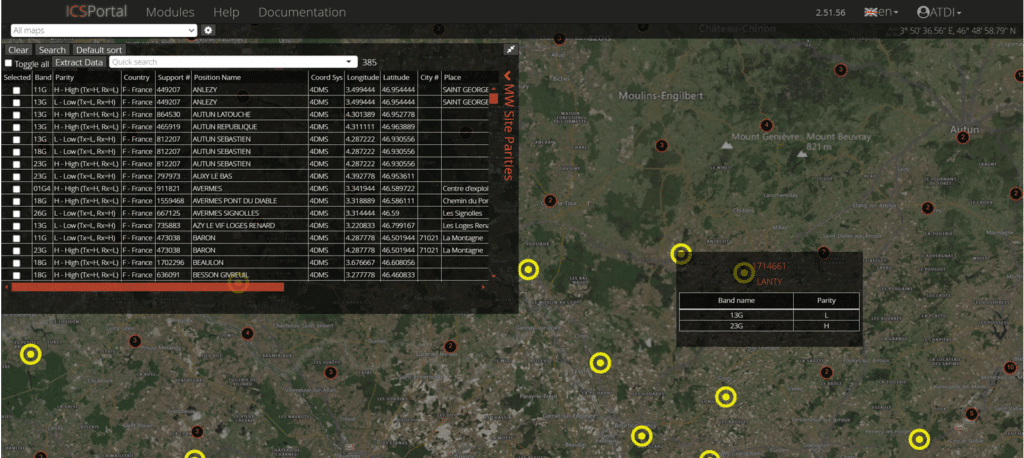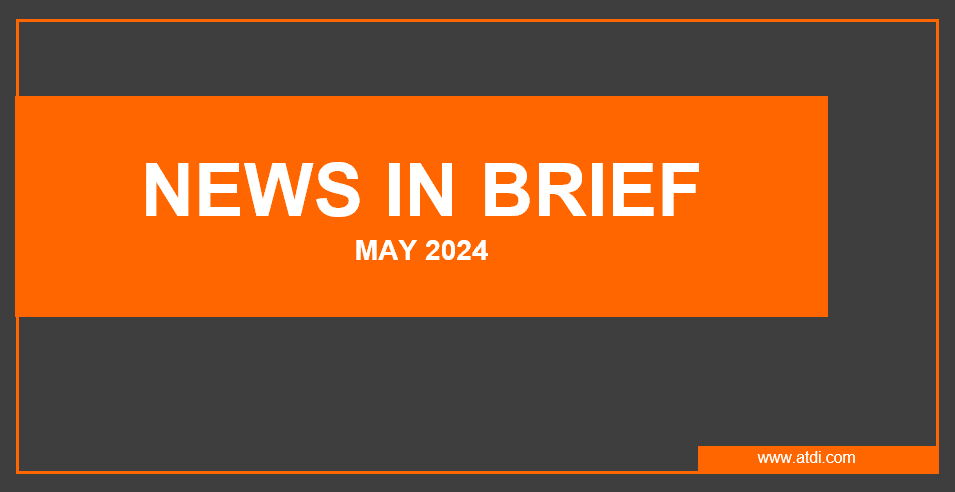With the first half of the year behind us, things are heating up at ATDI. In May, our team was busy exhibiting and networking at industry events. For updates, follow us on social media @ATDI or via our LinkedIn page.
Recent conflicts, like the Ukraine/Russia war, underscore evolving battlespace dynamics, particularly in airspace superiority with increased UAV and counter-drone usage. This month, we highlight new functions in HTZ Warfare for electronic warfare management to achieve air dominance in mission operations.
This edition showcases our recent delivery of ICS Portal, ATDI’s automated web service platform. Delivered to the Swiss regulator, this custom solution streamlines account management, license applications, document handling, billing and automated frequency assignment.
Lastly, in News in Brief, we share updates from some of our new customers from across the globe and a feature article on the South American mining industry. For more on these cases or to explore how we can support your business, contact us today.
With best wishes from
The ATDI Team

Recent conflicts provide evidence that battlespace dynamics are evolving. For example, in the Ukraine/Russia war, there has been a notable shift towards achieving airspace superiority. This is evident in the increased use of unmanned aerial vehicles (UAVs) and counter-drones. Drones are proving crucial to mission success, excelling in aerial reconnaissance, precision airstrikes, and enhancing operational flexibility and efficiency. By improving situational awareness, operational effectiveness, and force protection, the military can gain a significant advantage.
HTZ oversees all aspects of interception and jamming, encompassing the planning of offensive actions, support for asset optimisation, and communications planning. Conversely, it models and analyses the impact of jamming on its networks and assets.
Catch up on some of the latest new and improved features in HTZ Warfare for managing electronic warfare in the electromagnetic spectrum.
CPRA Jamming function: Enabling GNSS receiver on UAVs to be jammed. This function also supports anti-jamming capabilities on the UAV. It allows users to plan jamming deployments to counter enemy tactics, as well ensuring uninterrupted GPS reception by estimating the enemy’s GPS jamming capacity.
Drone flight paths analysis: HTZ manages the signal received power (RSRP), signal to interference plus noise ratio (SINR) and the reference signal received quality (RSRQ) for the proposed flight path. It models the flight paths both vertically, diagonally and horizontally and supports a subscriber database. It undertakes a connectivity analysis to identify areas with and without coverage to enable the optimisation of routes and ensure continuous connectivity with the network.
Counter-drone Efficiency analysis: This feature calculates the network coverage based on various height elevations or potential flight paths of the unauthorised UAV. These coverage calculations identify areas with poor signal coverage resulting from topography and building heights which could restrict the ability to block or jam signals.
Jamming threshold: The 'jamming threshold' parameter has been introduced which denotes any received signal surpassing a given value will be classified as jamming.
Jammer Uplink coverage: Checks what can be received by the jammer while it’s jamming a virtual transmitter located anywhere on the map.
Localisation: Addition of a new mode for DF localisation accuracy maps based on location and azimuth of the DF. The accuracy is only calculated if DFs are not aligned.
On-the-move capabilities: HTZ analyses network capabilities for moving elements such as convoys in hostile terrain and identifies locations for talk-through sites. It optimises the deployment of direction finders by identifying the best sites while undertaking DF baseline coverage assessment between assets. HTZ can be integrated with the DF system to display DF hits on the planner's screen.
Drone-to-drone communications: HTZ models drone-to-drone communications where one drone uses a high-altitude platform (HAP) to extend the communication range for the drone. HTZ applies the ITU-R 528 propagation model to model network coverage.

Check out the latest cartographic datasets released. These royalty-free datasets are a valuable addition to your cartographic toolkit and are accessible to the customer portal. Here's a summary of the data resolutions and their locations:
1m resolution – DTM/Clutter/Buildings: Salt Lake City Intl, USA. Marseille, France. Hallered, Sweden.
2m resolution – DTM/Clutter/Buildings : Magdeburg, Germany. Tampere, Finland. Karlskrona & Boras, Sweden.
2.5m resolution – DTM/Clutter/Buildings: Hong Kong.
20m resolution – DTM/Clutter: Bosnia & Croatia.
We continually refresh our map data library to guarantee your access to the most current maps. Stay tuned for updates!

The Swiss regulator Bakom reaffirms its partnership with ATDI to enhance its spectrum management solution with an automated web service. The regulator purchased ICS Portal, ATDI’s flagship automated spectrum management web service solution to transform its internal work processes. This robust spectrum engineering/database solution automates complex spectrum management tasks like coexistence, coordination, and workflows. This incremental project will cover all services, with completion scheduled at the end of 2025.
The ICS Portal will seamlessly integrate with the federal eGOV platform and offer secure user authentication through the e-IAM application, the identity and access management system of the Swiss Federal administration.
Project Manager Samar Kaddouri explains, “By leveraging web-based technologies, ICS Portal integrates the daily tasks of spectrum regulators into one package. The front-end user interface handles account management, license application submissions, document management, and billing, while the back-end synchronises with unified databases to manage end-to-end workflows and processes.”
Key features of ICS Portal include:
ICS Portal is fully customisable, allowing users to adapt the solution to meet their needs and internal processes. To learn more about this automated spectrum management solution, contact the team today.

SC4 Technology: Consulting company
Railway communications remain a robust market as operators strive to enhance their network management. SC4T, an Italian consultancy, has recently acquired HTZ Communications for GSM-R network planning. With guidance and training from the ATDI team, SC4T will use the software to plan, model, and optimise GSM-R networks across Europe

As the mining industry evolves, smart mines must seamlessly integrate multiple systems and applications to maintain operations using wireless networks. To support this demand, ATDI offers HTZ Communications, enabling mine operators to design, plan and manage wireless connectivity for their autonomous fleets, including trucks and drills.
Given the constantly changing environment within a mine, operators need to identify and predict how landscape changes impact network quality. HTZ addresses this by simulating network coverage, importing updated environmental data to calculate coverage based on terrain changes, and performing other RF functions such as identifying the best server, composite coverage, and coverage overlap.
Operator Netaxion reports significant improvements in network availability with HTZ, increasing from 97.98% to 99.99%. Previously, the operator used monitoring devices to analyse frequencies for interference. With HTZ, they have seen notable improvements in network capacity and coverage, directly attributed to the accuracy of propagation models implemented in HTZ, and its management of other functions like interference analysis and the use of population data.
HTZ manages a wide range of technologies from a few kHz to 1 THz, covering the entire lifecycle of radio networks. Key features include optimal location and site search to enhance network coverage and capacity, environmental modelling using high-resolution datasets and 3D models, and the ability to model outdoor-to-indoor communications, accounting for penetration and absorption losses to ensure buildings and structures do not impact coverage or cause interference. HTZ also supports dynamic spectrum access with frequency coordination and automated site planning, facilitating spectrum sharing and improving network connectivity.
Alongside Netaxion, ATDI works with other leading mining organisations like BHP, Rio Tinto and consultancy firms like Stracon. View our latest video on advanced network planning in a mine environment here.

Life is too short. Join an amazing workplace!
We're in a dynamic growth phase and are recruiting an experienced RF Engineer. This position provides RF engineering support for pre-sales consulting, technical proposals, product demonstrations, presentations, and support, as well as consultancy projects. The suitable candidate will also provide training in radio network planning, spectrum management, electronic warfare, and cartographic data management.
Ideal candidates should have:
The location for this role offers significant flexibility. After an initial induction, the candidate can choose to work remotely in the UK or Düsseldorf, Germany. For a complete job description, please visit our careers page. To submit your CV, contact us at careers@atdi-group.com

Stay updated and visit us at our upcoming events:
CommunicAsia, Singapore, 29-31 May – ATDI will exhibit at this regional flagship event, gathering service providers, regulators, vendors, and system integrators to discuss industry advancements. Our team will showcase a cutting-edge radio planning solution tailored for spectrum engineering and technical analysis.



